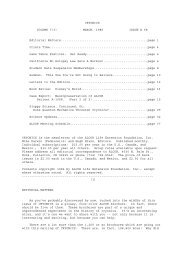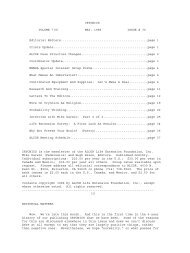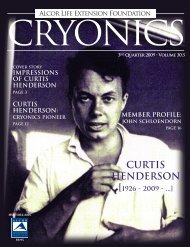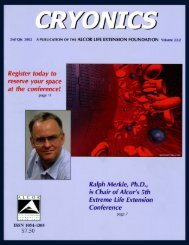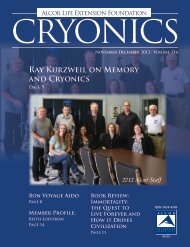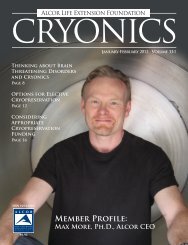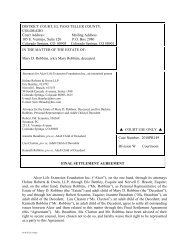Robert Ettinger - Alcor Life Extension Foundation
Robert Ettinger - Alcor Life Extension Foundation
Robert Ettinger - Alcor Life Extension Foundation
Create successful ePaper yourself
Turn your PDF publications into a flip-book with our unique Google optimized e-Paper software.
Bob <strong>Ettinger</strong> and the<br />
Cryobiologists<br />
By Charles Platt<br />
__________________<br />
His contributions are<br />
obvious: His seminal book<br />
energized activists from<br />
Curtis Henderson to<br />
Bob Nelson, and<br />
precipitated the first<br />
cryonics cases.<br />
Without him, would<br />
cryonics even exist?<br />
__________________<br />
I<br />
have often wondered how cryonics<br />
would have developed if Bob <strong>Ettinger</strong><br />
had not been around to champion the<br />
cause. His contributions are obvious: His<br />
seminal book energized activists from Curtis<br />
Henderson to Bob Nelson, and precipitated<br />
the first cryonics cases. Without him,<br />
would cryonics even exist?<br />
We should remember that Ev Cooper<br />
(writing as “N. Duhring”) came up with the<br />
idea separately and circulated his manuscript<br />
Immortality: Physically, Scientifically, Now<br />
two years before Doubleday published its<br />
edition of Bob’s book in 1964. Cooper’s<br />
<strong>Life</strong> <strong>Extension</strong> Society could legitimately<br />
claim to be the first cryonics organization,<br />
although of course it was only a discussion<br />
group. Karl Werner had not yet come up<br />
with the word “cryonics.”<br />
Looking back farther, British scientists<br />
Alan Parkes, Christopher Polge, and Audrey<br />
Smith evidently considered the possibility<br />
of human cryopreservation in the 1950s.<br />
Their success in cryopreserving red blood<br />
cells and bull semen led Parkes to remark,<br />
in an article in Scientific American: “Inevitably,<br />
we were drawn to a still more fascinating<br />
question: Could a whole animal survive<br />
freezing?” Smith subsequently pursued the<br />
reversible cryopreservation of hamsters,<br />
and Greg Fahy once showed me a paper<br />
coauthored by her that discussed the challenge<br />
of rewarming larger mammals. I don’t<br />
think it was coincidental that an illustration<br />
suggested something big enough for a human<br />
being.<br />
Going back farther, the implications of<br />
stopping and restarting life processes were<br />
explored in Luyet’s book “<strong>Life</strong> and Death at<br />
Low Temperatures,” based on his pioneering<br />
work in the 1930s and 1940s. And still<br />
farther back, in 1862, a novel titled “The<br />
Man with the Broken Ear” by French author<br />
Edmond About described a person<br />
being revived after being preserved by desiccation.<br />
Bob <strong>Ettinger</strong> once told me that he<br />
was aware of this novel.<br />
Clearly, cryonics was a concept that was<br />
ready to happen. Bob’s singular achievement<br />
was that he used the media to popularize it,<br />
encouraged its first application to human<br />
beings, and led an organization that pursued<br />
it with truly remarkable persistence.<br />
I once asked him if he felt that media<br />
coverage for cryonics in the 1960s had<br />
scared cryobiologists away from their prior<br />
work on organ cryopreservation. He readily<br />
agreed that the early cryonics cases unnerved<br />
the scientific community, but of<br />
course he tended to blame them for their<br />
lack of courage and vision.<br />
I had significant differences with Bob,<br />
most notably in the mid-1990s when the<br />
protocol at CI appeared to violate basic<br />
cryobiological principles for minimizing<br />
ice formation during initial cooling. (CI has<br />
subsequently made great efforts to use rapid<br />
cooling, as opposed to the slow process<br />
that was applied previously.) Bob scoffed at<br />
me for paying attention to anything a cryobiologist<br />
would say, but I think mostly he<br />
felt that their concerns were irrelevant. He<br />
seemed to believe that future science would<br />
be able to fix pretty much anything. When<br />
he moved to Phoenix for a while, I was<br />
told by someone at <strong>Alcor</strong> that he politely<br />
declined their offer of local standby help in<br />
the event that he might need it. As always,<br />
he placed his trust in a local mortician, a<br />
shot of heparin, some chest compressions,<br />
and a few bags of ice.<br />
This optimism inevitably put him at<br />
odds with the scientific community. We can<br />
only wait to find out whether he or they will<br />
have the last laugh.<br />
For myself, I hope that his optimism<br />
was not misplaced. �<br />
www.alcor.org Cryonics/Fourth Quarter 2011 19



